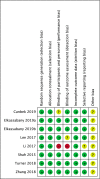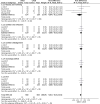Is continuous catheter adductor canal block better than single-shot canal adductor canal block in primary total knee arthroplasty?: A GRADE analysis of the evidence through a systematic review and meta-analysis
- PMID: 32443383
- PMCID: PMC7254479
- DOI: 10.1097/MD.0000000000020320
Is continuous catheter adductor canal block better than single-shot canal adductor canal block in primary total knee arthroplasty?: A GRADE analysis of the evidence through a systematic review and meta-analysis
Abstract
Background: The adductor canal block (ACB) has emerged as an alternative to the femoral nerve block (FNB) after total knee arthroplasty. This meta-analysis was conducted to investigate which ACB method provides better pain relief and functional recovery after total knee arthroplasty METHODS:: We conducted a meta-analysis to identify randomized controlled trials involving single-shot adductor canal block (SACB) and continuous catheter ACB (CACB) after TKA up to December 2019 by searching databases including the PubMed, Web of Science, Embase, Cochrane Controlled Trials Register, Cochrane Library, CBM, CNKI, VIP, and Wanfang databases. Finally, we included 8 randomized controlled trials involving 702 knees in our study. We used Review Manager Software and Grading of Recommendations Assessment, Development, and Evaluation profiler to perform the meta-analysis.
Results: Compared with SACB, CACB can achieve better postoperative pain relief at 24 and 48 h both at rest and after mobilization, lower amount of opioid consumption at 72 h, a shorter length of hospital stay (LOH) and larger range of motion (ROM). In addition, the Timed Up and Go (TUG) test results; quadriceps strength; and incidence of complications, including postoperative nausea and vomiting, DVT, catheter-related infections, catheter dislodgement and neurologic deficits, showed no significant difference between the two ACB methods.
Conclusion: The results of this study demonstrate that CACB is an effective alternative to SACB and can provide better pain relief, a shorter LOH, more degrees of maximum flexion and a lower amount of opioid consumption over time, but it provides a comparable level of recovery of quadriceps strength and mobility with a similar risk of catheter-related complications. Thus, CACB may be a better analgesia strategy than SACB after TKA at present.
Conflict of interest statement
The authors have no conflicts of interest to disclose.
Figures











Similar articles
-
Is Adductor Canal Block Better Than Femoral Nerve Block in Primary Total Knee Arthroplasty? A GRADE Analysis of the Evidence Through a Systematic Review and Meta-Analysis.J Arthroplasty. 2017 Oct;32(10):3238-3248.e3. doi: 10.1016/j.arth.2017.05.015. Epub 2017 May 17. J Arthroplasty. 2017. PMID: 28606458
-
Continuous adductor canal block is a better choice compared to single shot after primary total knee arthroplasty: A meta-analysis of randomized controlled trials.Int J Surg. 2019 Dec;72:16-24. doi: 10.1016/j.ijsu.2019.10.012. Epub 2019 Oct 12. Int J Surg. 2019. PMID: 31614202
-
Continuous adductor canal block provides better performance after total knee arthroplasty compared with the single-shot adductor canal block?: An updated meta-analysis of randomized controlled trials.Medicine (Baltimore). 2020 Oct 23;99(43):e22762. doi: 10.1097/MD.0000000000022762. Medicine (Baltimore). 2020. PMID: 33120783 Free PMC article.
-
Does Patient Perception Differ Following Adductor Canal Block and Femoral Nerve Block in Total Knee Arthroplasty? A Simultaneous Bilateral Randomized Study.J Arthroplasty. 2017 Jun;32(6):1856-1861. doi: 10.1016/j.arth.2017.01.025. Epub 2017 Jan 26. J Arthroplasty. 2017. PMID: 28215966 Clinical Trial.
-
Analgesic efficacy and quadriceps strength of adductor canal block versus femoral nerve block following total knee arthroplasty.Knee Surg Sports Traumatol Arthrosc. 2016 Aug;24(8):2614-9. doi: 10.1007/s00167-015-3874-3. Epub 2015 Nov 26. Knee Surg Sports Traumatol Arthrosc. 2016. PMID: 26611901 Review.
Cited by
-
Regional anesthesia for geriatric population.Saudi J Anaesth. 2023 Oct-Dec;17(4):523-532. doi: 10.4103/sja.sja_424_23. Epub 2023 Aug 18. Saudi J Anaesth. 2023. PMID: 37779559 Free PMC article. Review.
-
Positioning the Catheter Tip Anterior or Posterior to the Saphenous Nerve in Continuous Adductor Canal Block: A Mono-Centric Retrospective Comparative Study.Local Reg Anesth. 2022 Dec 29;15:97-105. doi: 10.2147/LRA.S383601. eCollection 2022. Local Reg Anesth. 2022. PMID: 36601486 Free PMC article.
-
Implementation and Postoperative Management of Continuous Adductor Canal Catheters for Total Knee Arthroplasty to Reduce Surgical Backlog Related to the COVID-19 Pandemic: An Acute Pain Service Nursing Perspective and Educational Resource.J Perianesth Nurs. 2023 Apr;38(2):186-192. doi: 10.1016/j.jopan.2022.04.012. Epub 2022 Apr 29. J Perianesth Nurs. 2023. PMID: 36243519 Free PMC article.
-
Multidimensional pain assessment and opioid use after total knee arthroplasty: continuous vs single-injection regional vs systemic analgesia.Pain Rep. 2025 Mar 18;10(2):e1257. doi: 10.1097/PR9.0000000000001257. eCollection 2025 Apr. Pain Rep. 2025. PMID: 40109369 Free PMC article.
-
The Impact of Femoral Nerve Anesthesia on Short-Term Clinical Outcomes and Opioid Claims After Total Knee Arthroplasty.Arthroplast Today. 2020 Nov 21;6(4):1016-1021.e9. doi: 10.1016/j.artd.2020.10.001. eCollection 2020 Dec. Arthroplast Today. 2020. PMID: 33385044 Free PMC article.
References
-
- Gao F, Ma J, Sun W, et al. Adductor canal block versus femoral nerve block for analgesia after total knee arthroplasty: a systematic review and meta-analysis. Clin J Pain 2017;33:356–68. - PubMed
-
- Jæger P, Zaric D, Fomsgaard JS, et al. Adductor canal block versus femoral nerve block for analgesia after total knee arthroplasty: a randomized, double-blind study. Reg Anesth Pain Med 2013;38:526–32. - PubMed
-
- Hanson NA, Allen CJ, Hostetter LS, et al. Continuous ultrasound-guided adductor canal block for total knee arthroplasty: a randomized, double-blind trial. Anesth Analg 2014;118:1370–7. - PubMed
-
- Li D, Yang Z, Xie X, et al. Adductor canal block provides better performance after total knee arthroplasty compared with femoral nerve block: a systematic review and meta-analysis. Int Orthop 2016;40:925–33. - PubMed
-
- Zhao XQ, Jiang N, Yuan FF, et al. The comparison of adductor canal block with femoral nerve block following total knee arthroplasty: a systematic review with meta-analysis. J Anesth 2016;30:745–54. - PubMed
Publication types
MeSH terms
Substances
LinkOut - more resources
Full Text Sources
Medical

